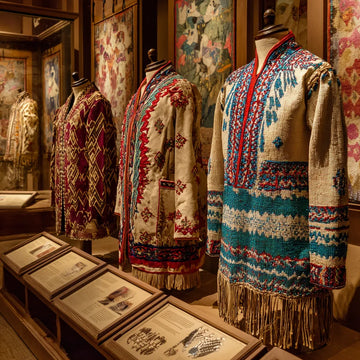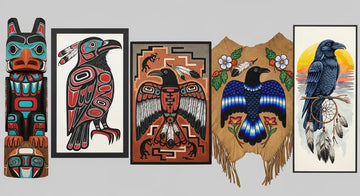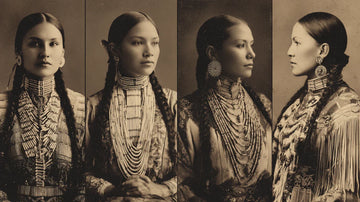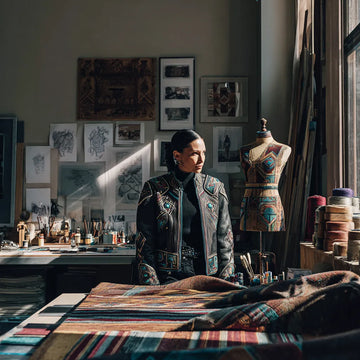The world of Native American clothing represents one of humanity's most sophisticated and culturally significant textile traditions. For centuries, indigenous artisans have created artisan garments that serve not only as functional clothing but as powerful expressions of cultural identity, spiritual beliefs, and artistic mastery. These handcrafted pieces tell stories that span generations, each stitch and bead carrying forward the wisdom and artistry of ancestral knowledge.

The Foundation of Traditional Materials
Understanding the craftsmanship of Native American clothing begins with appreciating the natural materials that form the foundation of these remarkable garments. Traditional artisans worked exclusively with materials provided by their environment, transforming raw resources into sophisticated textiles through generations of refined techniques.
Animal hides, particularly those from deer, elk, buffalo, and moose, served as the primary base for most garments. The process of transforming these hides into workable leather required extensive knowledge of tanning techniques, often involving the use of animal brains, bone marrow, and various plant materials. The resulting leather was soft, durable, and perfectly suited for the creation of everything from everyday clothing to ceremonial regalia.

Beyond leather, indigenous artisans incorporated an impressive array of natural materials into their artisan garments. Shells from distant coastlines were traded inland to create decorative elements, while local stones, seeds, and bones were carved and shaped into beads and ornaments. Bird feathers, particularly those from eagles and other sacred birds, held deep spiritual significance and were incorporated into garments with great reverence and ceremony.
The Art of Beadwork: Precision in Every Stitch
Perhaps no aspect of Native American garment craftsmanship is more immediately recognizable than the intricate beadwork that adorns traditional clothing. Before European contact, indigenous artisans created beads from natural materials including shells, stones, bones, seeds, and even small pieces of copper. These early beads required enormous skill to create, as each one was individually shaped, drilled, and polished by hand.

The techniques used to apply beadwork to garments varied significantly between tribes and regions, each developing distinctive styles and patterns. Loom beading created symmetrical, geometric designs that could be applied to belts, sashes, and decorative strips. The "lazy stitch" technique, commonly used by Plains tribes, involved sewing small groups of beads in parallel rows, creating flowing, organic patterns that moved naturally with the garment.
The patterns and colors used in beadwork were never random; they carried deep cultural meanings and often told specific stories. Geometric patterns might represent natural phenomena like mountains, rivers, or the movement of animals, while floral designs incorporated in later periods reflected the influence of trade relationships and cultural exchange.
Regional Variations in Beadwork Styles
Each region developed its own distinctive approach to beadwork, creating identifiable styles that reflected local aesthetics and cultural values. Plains tribes favored bold geometric patterns in bright colors, often incorporating symbols that represented important spiritual concepts or historical events. Woodland tribes, particularly in the Northeast, developed intricate floral patterns that reflected their forest environment and often incorporated curved lines and naturalistic motifs.

Quillwork: The Precursor to Beadwork
Before the widespread adoption of glass beads through European trade, porcupine quillwork represented the pinnacle of decorative artistry in many Native American cultures. This uniquely North American art form involved the careful preparation, dyeing, and application of porcupine quills to create intricate patterns and designs on clothing and accessories.
The process of creating quillwork began with the careful collection of quills from porcupines, a task that required both skill and patience. The quills were then cleaned, sorted by size, and dyed using natural pigments derived from plants, berries, and minerals. The actual application of quillwork to garments involved several different techniques, including sewing, weaving, and wrapping, each creating distinctive textural effects.

Quillwork was traditionally a woman's art, passed down through generations of female artisans who guarded the techniques and meanings behind specific patterns. The creation of quillwork required not only technical skill but also deep cultural knowledge, as many patterns held sacred meanings and could only be used by individuals who had earned the right to wear them.
Featherwork and Sacred Adornments
The incorporation of feathers into Native American clothing represents one of the most spiritually significant aspects of traditional garment craftsmanship. Feathers, particularly those from eagles, hawks, and other birds of prey, were considered sacred elements that connected the wearer to the spiritual realm and the natural world.
The process of incorporating feathers into garments required deep knowledge of both the spiritual significance of different bird species and the technical skills needed to properly prepare and attach feathers to clothing. Eagle feathers, the most sacred of all, were typically earned through acts of bravery or spiritual achievement and were incorporated into garments with great ceremony and reverence.

The arrangement of feathers in garments followed strict cultural protocols, with specific patterns and orientations carrying particular meanings. War bonnets, perhaps the most famous example of featherwork, required years to complete and represented a warrior's achievements and spiritual standing within the community.
Textile Techniques: Weaving and Fiber Arts
While much attention is paid to beadwork and decorative elements, the underlying textile techniques used in Native American clothing represent sophisticated approaches to fiber arts that developed over millennia. Different regions developed distinct weaving traditions based on available materials and cultural preferences.
In the Southwest, Pueblo peoples developed complex weaving techniques using cotton and later wool, creating textiles with intricate patterns and rich colors. These weavers used traditional backstrap looms and upright looms to create everything from everyday clothing to ceremonial blankets and sashes.

In other regions, artisans developed techniques for working with plant fibers, creating everything from fishing nets to decorative elements for clothing. The ability to transform raw plant materials into functional textiles required extensive knowledge of local flora and sophisticated processing techniques.
Moccasins: Footwear as Art
No discussion of Native American garment craftsmanship would be complete without examining the artistry of traditional moccasins. These essential pieces of footwear represent some of the most sophisticated examples of leather working and decorative arts in indigenous cultures.
The construction of moccasins required detailed knowledge of foot anatomy, gait patterns, and the specific requirements of different activities. Plains moccasins featured hard soles suitable for long-distance travel, while woodland moccasins used soft soles that provided better grip and sensitivity for forest travel.

The decorative elements of moccasins often reflected the same patterns and meanings found in other garments, creating a cohesive visual language that identified the wearer's tribal affiliation and social status. The level of decoration on moccasins could indicate whether they were intended for everyday wear or special ceremonial occasions.
Contemporary Preservation and Innovation
Today's Native American artisans continue to honor traditional techniques while adapting them for contemporary purposes. Many indigenous artists work to preserve ancient methods while also exploring new applications for traditional skills. This ongoing evolution ensures that the craftsmanship of Native American clothing remains a living tradition rather than a historical artifact.
Modern artisan garments often blend traditional techniques with contemporary materials and designs, creating pieces that honor cultural heritage while meeting the needs of modern wearers. Explore our unique jackets that showcase this beautiful fusion of traditional craftsmanship and contemporary style.

The preservation of traditional techniques often involves formal education programs, apprenticeships, and cultural centers where knowledge is passed from master artisans to new generations. These programs ensure that the sophisticated skills required for traditional garment making continue to be available to future generations.
Cultural Significance and Spiritual Meanings
Understanding the craftsmanship of Native American clothing requires appreciation for the deep cultural and spiritual meanings embedded in these garments. Traditional clothing served far more than utilitarian purposes; it functioned as a form of communication, expressing the wearer's identity, achievements, spiritual beliefs, and connection to their community.
Many traditional garments were created for specific ceremonies or life events, with particular patterns and materials chosen for their spiritual significance. The process of creating these garments often involved prayers, ceremonies, and the observance of specific protocols that honored the materials and the cultural traditions they represented.

The patterns and symbols used in traditional garments often functioned as a form of visual language, conveying complex cultural information to those who understood their meanings. This symbolic system created a rich tapestry of communication that extended far beyond the merely decorative.
The Economics of Traditional Craftsmanship
The creation of traditional Native American clothing represented a significant economic investment in both time and materials. Master artisans might spend months or even years creating a single ceremonial garment, with the value of the finished piece reflecting not only the cost of materials but also the time, skill, and cultural knowledge invested in its creation.
Trading networks that spanned the continent allowed artisans to access materials from distant regions, creating economic relationships that supported the creation of increasingly sophisticated garments. These trade relationships often influenced design elements, as new materials and techniques were incorporated into traditional practices.
Today, the market for authentic artisan garments continues to support Native American communities, providing economic opportunities for skilled artisans while preserving traditional knowledge and techniques. Discover home decor inspired by tradition that celebrates this rich artistic heritage.
Technical Innovations in Traditional Contexts
The sophisticated techniques developed by Native American artisans often involved innovations that solved complex technical challenges. The development of specialized tools, the creation of effective dyes and tanning agents, and the perfection of construction techniques all represent significant technological achievements.
These innovations were often closely guarded secrets, passed down through family lines or specific cultural groups. The knowledge required to create certain types of garments could take decades to master, creating a system of skilled specialists within communities.

The precision required for techniques like quillwork and fine beadwork demanded the development of specialized tools and methods. These technical innovations often reflected deep understanding of materials science, ergonomics, and design principles that remain relevant today.
Regional Diversity and Tribal Distinctiveness
The diversity of Native American clothing styles across different regions and tribes reflects the rich variety of indigenous cultures throughout North America. Each group developed distinctive approaches to garment construction, decoration, and meaning, creating a tapestry of artistic traditions that defies simple categorization.
Plains tribes developed clothing suited to their nomadic lifestyle and the demands of buffalo hunting, creating garments that were both practical and richly decorated. Woodland tribes, working in forest environments, developed different construction techniques and decorative approaches that reflected their environment and cultural practices.
Southwest tribes, with access to cotton and later wool, developed sophisticated weaving traditions that created textiles of extraordinary beauty and complexity. Arctic peoples, facing extreme environmental challenges, developed innovative approaches to creating warm, waterproof garments using available materials.

Modern Applications and Contemporary Relevance
The techniques and aesthetic principles developed by Native American artisans continue to influence contemporary fashion and design. Modern designers often draw inspiration from traditional patterns, construction methods, and decorative techniques, creating contemporary interpretations that honor the original traditions while meeting modern needs.
The growing appreciation for handcrafted, sustainable fashion has created renewed interest in traditional techniques. Many contemporary consumers seek artisan garments that reflect the care, skill, and cultural depth found in traditional Native American clothing.
Shop our accessories collection to discover how traditional craftsmanship techniques are being adapted for modern wear, creating pieces that honor cultural heritage while meeting contemporary style needs.

Conclusion: Honoring Tradition Through Understanding
The intricate craftsmanship of Native American clothing represents far more than the creation of beautiful garments; it embodies a sophisticated understanding of materials, techniques, and cultural meanings that has been refined over centuries. These artisan garments serve as tangible connections to rich cultural traditions and demonstrate the highest levels of artistic achievement.
Understanding and appreciating this craftsmanship requires recognizing both the technical skill involved in creating these garments and the deep cultural knowledge that gives them meaning. Each technique, from the precise placement of beads to the careful selection of feathers, reflects generations of accumulated wisdom and artistic refinement.
As we continue to appreciate and learn from these traditions, we honor not only the skilled artisans who created these remarkable garments but also the living cultures that continue to preserve and evolve these practices. The craftsmanship of Native American clothing offers timeless lessons in the value of patience, skill, cultural knowledge, and the deep connection between artisan and community.
By supporting contemporary Native American artisans and learning about traditional techniques, we can help ensure that these remarkable traditions continue to thrive and inspire future generations. The beauty and sophistication of Native American garment craftsmanship remain as relevant today as they were centuries ago, offering both aesthetic pleasure and profound cultural insight.

The journey through the world of Native American garment craftsmanship reveals a tradition that combines technical mastery with spiritual depth, creating works of art that serve as both functional clothing and profound cultural expression. These traditions continue to inspire and inform contemporary design, ensuring that the wisdom of ancestral knowledge remains vibrant and relevant in our modern world.




